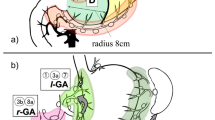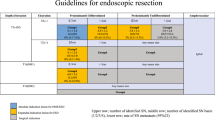Abstract
Background
We propose a new classification for the location of gastric cancer — the PTD classification (i.e., zones P, T, and D; see below), with the zones classified according to the physiological lymphatic flow.
Methods
Three hundred and thirty-six patients with T1 or small T2 gastric cancer who underwent sentinel node mapping at our hospital were enrolled. The relationship between the location of the gastric cancer and the physiological lymphatic flow derived from sentinel node mapping was investigated. Lymphatic basins were defined as lymphatic zones divided by the stream of stained lymphatic canals.
Results
One hundred and forty-six patients underwent standard gastrectomy with more than D2 dissection and the other 190 patients underwent function-preserving gastrectomy with the omission of lymph node dissection outside the lymphatic basin. In the former group, the progression pattern of lymph node metastasis was observed; nodal metastasis occurred in sentinel nodes first, and rarely extended outside the lymphatic basin. In the latter group, none of the patients have had a recurrence. The PTD classification we propose is as follows: the dividing line between the proximal region (zone P) and the transitional region (zone T) is the line that links the point of the watershed between the left gastroepiploic artery and right gastroepiploic artery, to the point that is the inflow point of the first descending branch of the left gastric artery; and the dividing line between zone T and the distal region (zone D) is an arc at a radius of 8 cm from the pylorus. There were no lymphatic basins within the right gastric artery area for tumors located in zone T.
Conclusion
The advantage of the PTD classification is that if the PTD classification were to be used as a guide for gastric resection procedures, preservation of the pylorus would become possible without diminishing the prognosis in patients with cT1N0 cancer located in zone T.
Similar content being viewed by others
References
Japanese Gastric Cancer Association (1998) Japanese classification of gastric carcinoma, 2nd English edn. Gastric Cancer 1:10–24
Miwa K, Kinami S, Taniguchi K, et al. (2003) Mapping sentinel nodes in patients with early-stage gastric carcinoma. Br J Surg 90:178–182
Hiratsuka M, Miyashiro I, Ishikawa O, et al. (2001) Application of sentinel node biopsy to gastric cancer surgery. Surgery 129:335–340
Kitagawa Y, Fujii H, Mukai M, et al. (2002) Radio-guided sentinel node detection for gastric cancer. Br J Surg 89:604–608
Ishizaki M, Kurita A, Kubo Y, et al. (2006) Evaluation of sentinel node identification with isosulfan blue in gastric cancer. Eur J Surg Oncol 32:191–196
Ichikura T, Chochi K, Sugasawa H, et al. (2006) Individualized surgery for early gastric cancer guided by sentinel node biopsy. Surgery 139:501–507
Tonouchi H, Mohri Y, Tanaka K, et al. (2005) Laparoscopic lymphatic mapping and sentinel node biopsies for early-stage gastric cancer: the cause of false negativity. World J Surg 29:418–421
Kim MC, Kim HH, Jung GJ, et al. (2004) Lymphatic mapping and sentinel node biopsy using 99 mTc tin colloid in gastric cancer. Ann Surg 239:383–387
Song X, Wang L, Chen W, et al. (2004) Lymphatic mapping and sentinel node biopsy in gastric cancer. Am J Surg 187:270–273
Gretschel S, Bembenek A, Ulmer Ch, et al. (2005) Prediction of gastric cancer lymph node status by sentinel lymph node biopsy and the Maruyama computer model. Eur J Surg Oncol 31:393–400
Nakajima T. (2002) Gastric cancer treatment guidelines in Japan. Gastric Cancer 5:1–5
Miwa K, Miyazaki I, Sahara H, et al. (1995) Rationale for extensive lymphadenectomy in early gastric carcinoma. Br J Cancer 72:1518–1524
Yokota T, Ishiyama S, Saito T, et al. (2004) Lymph node metastasis as a significant prognostic factor in gastric cancer: a multiple logistic regression analysis. Scand J Gastroenterol 39:380–384
Gotoda T, Yamamoto H, Soetikno RM (2006) Endoscopic submucosal dissection of early gastric cancer. J Gastroenterol 41:929–942
Nakajima T (2002) Gastric cancer treatment guidelines in Japan. Gastric Cancer 5:1–5
Ohwada S, Nakamura S, Ogawa T, et al. (1999) Segmental gastrectomy for early cancer in the mid-stomach. Hepatogastroenterology 46:1229–1233
Furukawa H, Hiratsuka M, Imaoka S, et al. (1999) Phase II study of limited surgery for early gastric cancer: segmental gastric resection. Ann Surg Oncol 6:166–170
Maki T, Shiratori T, Hatafuku T, et al. (1967) Pylorus-preserving gastrectomy as an improved operation for gastric ulcer. Surgery 61:838–845
Isozaki H, Okajima K, Momura E, et al. (1996) Postoperative evaluation of pylorus-preserving gastrectomy for early gastric cancer. Br J Surg 83:266–269
Nakane Y, Michiura T, Inoue K, et al. (2002) Length of the antral segment in pylorus-preserving gastrectomy. Br J Surg 89:220–224
Nishikawa K, Kawahara H, Yumiba T, et al. (2002) Functional characteristics of the pylorus in patients undergoing pylorus-preserving gastrectomy for early gastric cancer. Surgery 131:613–624
Urushihara T, Sumimoto K, Shimokado K, et al. (2004) Gastric motility after laparoscopically assisted distal gastrectomy, with or without preservation of the pylorus, for early gastric cancer, as assessed by digital dynamic X-ray imaging. Surg Endosc 18:964–968
Michiura T, Nakane Y, Kanbara T, et al. (2006) Assessment of the preserved function of the remnant stomach in pylorus-preserving gastrectomy by gastric emptying scintigraphy. World J Surg 30:1277–1283
Kodama M, Koyama K (1991) Indications for pylorus preserving gastrectomy for early gastric cancer located in the middle third of the stomach. World J Surg 15:628–633
Kodera Y, Yamamura Y, Kanemitsu Y, et al. (2001) Lymph node metastasis in cancer of the middle-third stomach: criteria for treatment with a pylorus-preserving gastrectomy. Surg Today 31:196–203
Morii Y, Arita T, Shimoda K, et al. (2002) Indications for pylorus-preserving gastrectomy for gastric cancer based on lymph node metastasis. Hepatogastroenterology 49:1477–1480
Matsuura Y (1961) The study of shape of stomach using X-ray examination of the upper gastrointestinal tract (in Japanese). Kanazawa I-Rikagaku Gousyo 63:107–155
Author information
Authors and Affiliations
Corresponding author
About this article
Cite this article
Kinami, S., Fujimura, T., Ojima, E. et al. PTD classification: proposal for a new classification of gastric cancer location based on physiological lymphatic flow. Int J Clin Oncol 13, 320–329 (2008). https://doi.org/10.1007/s10147-007-0755-x
Received:
Accepted:
Published:
Issue Date:
DOI: https://doi.org/10.1007/s10147-007-0755-x




